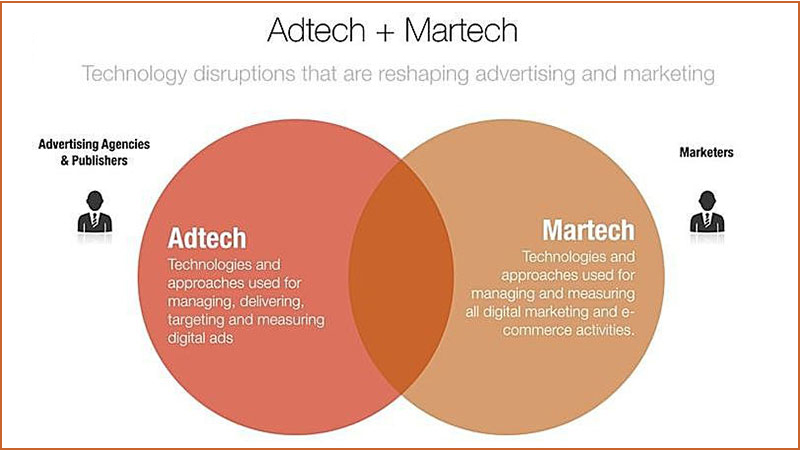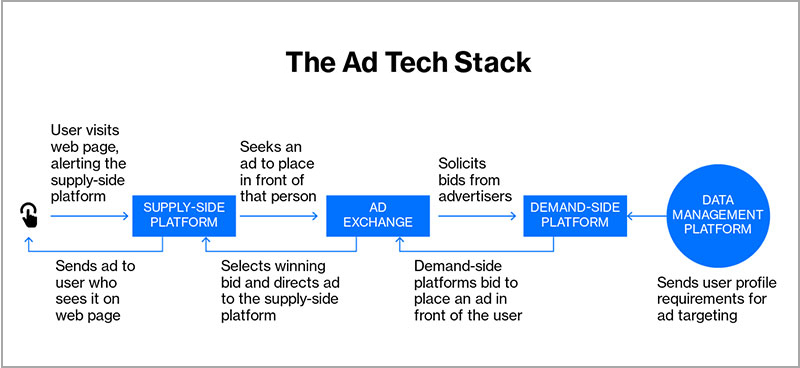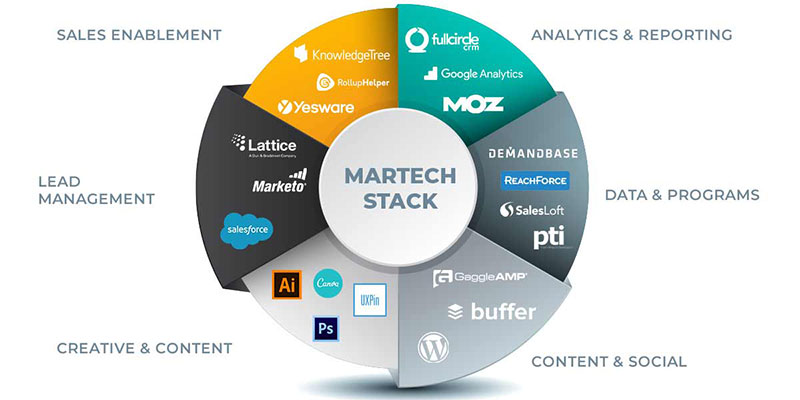
Most people are familiar with or at least have heard of AdTech. But what is MadTech?
This term describes the concurrence of online marketing and advertising technologies.
The term was first coined back in 2015 by marketer consultant David Raab. He shared a MadTech chart on Twitter, noting that it combined marketing and advertising technology.
For example, it brings together the personalized, individual reach of MarTech with the massive data pools of AdTech.
Marketing and advertising businesses used to exist in parallel yet separate worlds. Each offered unique tools and results.
But things started to change. Even a fully integrated MarTech stack can’t deliver a consistent customer experience.
Advertising still plays a major role in a customer’s brand experience. Moreover, advertising itself has become more personalized and interactive.
Consumers don’t make a distinction between marketing and advertising interactions. Neither should marketers.
The solution is MadTech. The convergence of digital advertising technology and marketing technology.
It helps companies deliver a unified, consistent, and personalized experience across all touchpoints.
In the following section, take a dive into what MadTech is, how it came to be, and whether it is here to stay.
Why Was MadTech Created?

Many companies struggle to integrate data and technology in their marketing departments. It is not the only challenge there is.
An even a bigger one is integrating MarTech with AdTech. It is, however, inevitable and it has a very appropriate name: MadTech.
AdTech is an umbrella term for advertising technology. It includes software and tools used by advertisers, ad agencies, publishers, and other industry players.
These help with the strategic planning and management of advertising or monetization activities. Its purpose is to research audiences and deliver targeted ads.
MarTech (marketing technology) is the term for the software and tech tools marketers leverage to plan, execute, and measure marketing campaigns.
MarTech tools automate and streamline marketing processes. They help to collect and analyze data and provide ways to reach and engage with the target audience.
No wonder, then, that these two terms often appear next to each other. MadTech is a transition from subsequent to concurrent communications.
In the past, the communication line from the brand to the customer was a direct one.
The brand was often presented to the customer via television, radio, and print. It was also presented via outdoor advertisements and at the point-of-sale.
Now, digital media enables the simultaneous communication of story elements that form a single concept.
The driving force behind MadTech is the same as the one pushing for MarTech integration. Technology enables marketers to meet the customers’ expectations.
It does so by providing customer data, greater analytical processing capability, and expanding channels for customer interaction.
We can help you turn your idea into reality, take over your existing project, or extend your current development team.
Schedule a free consultation at hello@tms-outsource.com, or fill out the form and we will follow up with you shortly.
The Elements of MadTech
MadTech is a mash-up of MarTech and AdTech. It is easy to guess that it consists of elements of marketing, advertising, and technology.
Originally, AdTech took care of advertising and MarTech looked after marketing. Those two existed at the same time but at different stages of the sales funnel.
With time, however, the line separating them became more and more blurry.
AdTech helps advertisers to create, execute, manage, and measure all advertising activity. It does this across multiple channels, such as websites, social media, and apps.
It involves acquisitions, views, impressions, and other measurable data related to ads and ad campaigns.
MarTech aims to enable marketers to build, roll out, and manage marketing activity. This includes A/B testing, email marketing, social media management, personalization, user feedback, and web analytics.
Online marketing and advertising consists of a few specific technology platforms.
AdTech Stack

The following are technology platforms that make up the AdTech stack:
DSP (Demand-site platform)
A DSP is a system for advertisers to buy and manage ad inventories from multiple ad sources through a single interface.
It uses intelligent software to bid on inventories using an auction process. This makes the buying and selling of ads cheaper and more reliable.
SSP (Supply-side platform or sell-side platform)
SSP enables web publishers and digital media owners to manage their advertising inventory. They can fill it with ads and receive revenue.
The SSP allows publishers to sell their impressions to the right buyers at the maximum price.
Ad exchange platforms
These facilitate the buying and selling of media advertising inventory from ad networks. Prices for the inventory are determined through real-time bidding.
Ad network
At the most basic level, they pool inventory of unsold ads from publishers and sell it to advertisers. They earn money by taking a cut of ad revenue, sometimes marking up inventory before selling it
Ad server platforms
These manage and run online advertising campaigns. Ad servers are responsible for making instant decisions about what ads to show on a website.
They then serve them and collect and report relevant data (impressions, clicks, etc.).
SEM (Search Engine Marketing) platforms
These promote websites, improving their visibility in paid search engine results pages (SERPs).
MarTech Stack

The following are technology platforms that make up the MarTech stack:
Web-analytics tools
They analyze the data from a mobile app or a website to discover how visitors interact with a website. They measure the effectiveness of marketing activities and improve the user experience of a website or app.
CRM platforms
These store and manage interactions a business has with current and potential customers.
Social media management platforms
Users can build, schedule, and measure the performance of social media activities and posts.
SEO and content optimization tools
These help marketers to improve their ranking in search engine search results.
CDPs (Customer Data Platforms)
Keeps user data in one place. Companies can access that information to implement personalized marketing strategies across multiple channels.
Personalization software
This creates personal website experiences based on user preferences. It helps organizations to meet their customers’ needs more efficiently and increase customer satisfaction.
It is often used by product and development teams to maximize a website’s performance. Also to convert website visitors into buyers.
CMPs (Consent Management Platforms)
These present consent options to visitors of websites and mobile apps. They capture consent about the use of personal data and the authorized vendors.
They then relay that consent profile to relevant ad tech vendors in the ecosystem.
MadTech – Is It Here to Stay?

Image source: digitalkites.com
The idea of marketing has changed significantly in recent years. Buyers have smartened up and are not impressed by hyperbole in advertising.
Exaggerated claims no longer wield influence. This is due to the constant scrutiny of the social media crowd.
There has been a transition to a new marketing era. Here, complete transparency is the only road to success.
Wrapping untruths in fiction does not accomplish anything anymore. Marketers can only succeed if they present facts coated with emotions.
Another challenge for marketers is the demand to have real-time communication with brands and businesses. It is no longer enough to put up some billboards and show customers a few TV ads throughout the year.
Each technological platform involves collecting and processing massive amounts of data.
MadTech has begun to gain momentum as it responds to the needs of present-day marketers. It can integrate AdTech and MarTech into one seamless unit.
It means that businesses do not control the whole communication supply chain. Nor the processes involved in creating and dispensing communications to the customers.
Digital advertising allows for interaction and dialogue between marketers, customers, and the media. In a sense, the three become partners (or even co-creators) in the advertising experience.
So, to answer the question: yes, MadTech is a reality and it is here to stay.
Benefits of MadTech
Present-day marketers can reap multiple benefits from MadTech. Consider the following:
A Conglomeration of Both Worlds
Both MarTech and AdTech require the collecting and processing of huge amounts of data.
MadTech allows marketers to learn about and track market needs. It combines marketing and advertising into one unified category.
Increased Personalization at Scale
With MadTech, publishers can use customer information to create and roll out personalized ad campaigns. That encourages relationships and moves leads across touchpoints.
Improved Media Planning and Buying Insights
MadTech allows marketers and advertisers to better understand, assess, and measure their media buys, ad inventory, and outreaches.
With better metrics, comes effective ad campaigns. These will consequently lead to growth in acquisition and revenue.
The MadTech stack informs media buys. This enables marketers to make an emotional connection with customers.
It helps in customer identification and engagement at a more detailed level.
Simplifying Your Tech Stack
It is easy to feel overwhelmed by the number of MarTech and AdTech options available.
It is also easy to amass unnecessary solutions. But this results in disjointed data, confusing processes, and misunderstood customers.
MadTech solves this problem by providing a unified and comprehensive platform. It fills publishers’ data collecting and targeting needs.
Making Use of ML and AI
Machine learning and artificial intelligence play a huge part in MadTech.
Take as an example Amazon’s ‘anticipatory shipping’. It uses machine learning to package items for certain areas even before a customer has placed an order.
Breaking Down Data Silos
AdTech and MarTech are both driven by data. MadTech helps in eliminating data silos.
With that singular platform comes a more centralized and connected organization. It makes valuable customer data accessible across departments and campaigns.
For instance, it can combine customer data (first-party data) from various MarTech platforms with advertising channels data (third-party data). It then creates audiences to perform people-based marketing.
Final thoughts on MadTech
Technology is shaking the advertising, marketing, and media worlds to their core. The lines between them have blurred and are disappearing.
Technology, advertising, and media converge and change the way customers “consume” content. The crisscrossing of advertising, media, and technology is echoing throughout the marketing world.
It changes the way marketers advertise. It affects how media platforms relate to customers and advertisers.
MadTech makes it possible for anyone with a budget to gain equal access to data and delivery. This is because they are available as external services.
The only difference between marketers will be the decision-making. Those who make smart decisions about what messages to deliver to which customers, when, and via which media, will succeed.
This will bring back to the fore all the essential marketing skills. Skills such as branding, creative development, positioning, and value.
MadTech is not an invention. It is an answer to the need that has evolved in recent years.
Reliance on data and the connection between marketing and advertising have prompted the emergence of MadTech. MadTech handles the evolution of modern-day marketing.
Looking for a development partner?
If you’re looking for a technology partner, development team augmentation, or just a company for your software&app development initiatives, consider TMS.
TMS is a software and digital company in Belgrade, Serbia. We develop innovative and modern software.
A few examples include premium booking software Trafft, MedTech apps like MR Prepare, or MarTech/AdTech apps like the Advise Media Suite, among other great software examples.
Check out our services and also some of the work we’ve done for our clients. Who knows, maybe we’ll form a successful relationship.
Schedule a free consultation at hello@tms-outsource.com, or fill out the form and we will follow up with you shortly.
If you enjoyed reading this article on MadTech, you should check out this one about proof of concept vs prototype.
We also wrote about a few related subjects like MVP tests, how to hire a web development team, software development budget, financial software development companies, software development outsourcing trends, business pivot examples, lean software development principles and personalization algorithms.

